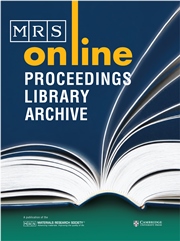No CrossRef data available.
Article contents
Interaction of an Aromatic Molecule with a Surface
Published online by Cambridge University Press: 25 February 2011
Abstract
The interaction between an aromatic molecule and the graphite basal plane is constructed using a Lennard-Jones 6–12 potential. The corrugation of the potential across the surface, the binding energies and vibrational frequencies of the aromatic molecules on the basal plane have been calculated and compared with experimental data. We have also calculated the interaction between a rare-gas atom and an aromatic molecule using two independent models, one based on the pairwise sum of the Lennard-Jones potential and the other on the Effective Medium Theory (EMT) for the repulsive part and a Van der Waals dispersion term for the attractive part. Our results are then compared with available experimental data.
Information
- Type
- Research Article
- Information
- Copyright
- Copyright © Materials Research Society 1989

